The Making of IGPX 3D Animation Step 3: Motion [part 1]
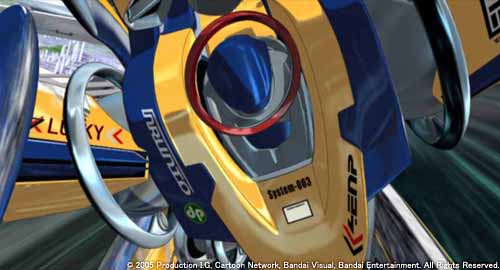
Hyper-dynamic battles between lavishly detailed IG machines running at speed higher than 400 km/h is definitely one of IGPX most impressive characteristics.
For this reason, we decided to get inside Production I.G's 3D Room, and ask the computer graphics team to tell us everything about the creative process behind the astounding mechs of IGPX.
STAFF PROFILE
Miki Yoshida
3DCGI. Yoshida is the leader of the IGPX 3D animation team. His main works include: Blood: The Last Vampire (2000), Kaidohmaru (2001) and Ghost in the Shell: Stand Alone Complex (2002).
Toshio Kawaguchi
3DCGI. Kawaguchi came to I.G bringing his long experience at Sudio Ghibli. He worked in titles such as Laputa - Castle in the Sky (1989), Porco Rosso (1992), Ponpoko (1994), Jin-Roh (2000) and Windy Tales (2004).
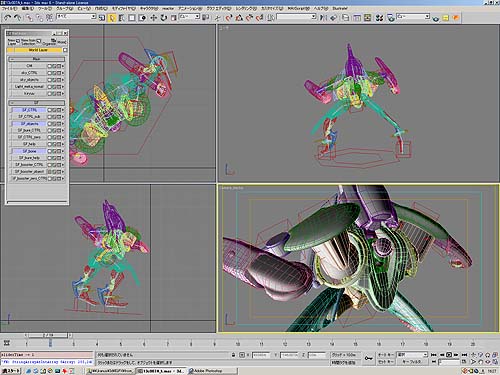
Can you explain the process of rendering pictures into motion?
Yoshida: For IGPX, we implemented a different process to do the 3D work compared to what we are used to do at I.G. Basically what happened before was, after the original storyboards came out, the layouts were decided, then the rough drawings were done. So the 3D team worked with those drawing sheets to start with.
Director Hongo thought that this standard process - I mean taking all these steps - was not adequate for utilizing the talent of the 3D team or to portray the uniqueness of the individual personalities. After discussing his points, we thought we could try a new method of bringing the storyboards straight to the 3D team, so that each one of us could render it into motion by translating the storyboard content onto the screen.
In other words, for IGPX, the process of motion rendering was not a simple job of just arranging poses and rendering in 3D models as instructed. Rather, we first looked at the storyboards, measured the length of each scene and interpreted the story, and then each one of us would move an IG machine or let it run along the course.
This is the key point in the IGPX production. We skipped the process of preparing the layout plan; instead, we rendered it to motion directly. This was a new experiment, so the staff in the 3D team as well as the director himself were a little nervous about the outcome.
But when it was actually implemented, there was luckily not much confusion. I'm quite amazed at the solid system we have of double-checking the work within our team. This is mainly because we have in our team Toshio Kawaguchi, who has a long experience in 2D animation. Kawaguchi-san checked our work from the animator's point of view. Then after we do the touch-up, we have Atsushi Takeuchi, who is another renowned animator, to recheck our work as a 3D director. Thanks to this process of double-checking, each scene comes up really cool to watch.
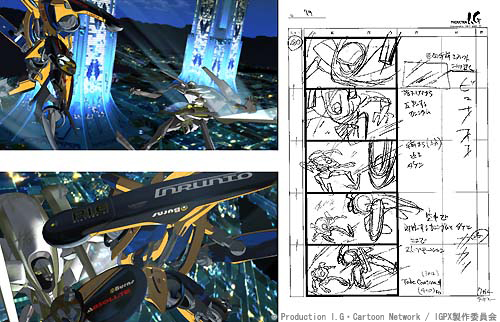
Now, Kawaguchi-san, can you explain to us the role you play in the process?
Kawaguchi: I start by roughly checking the basic structure of the scene, for instance, the layouts and to see whether the storyline appropriately follows the storyboards. Usually when I check over two to three times, I have to order some retakes in house and to the subcontractors. But as we progressed into the series, I think the staff became more aware of my intentions and major corrections decreased remarkably.
What did you think of altering or skipping the usual method of using the 2D rough drawings by animators for the 3D scenes?
Kawaguchi: Participating in this IGPX project, I did feel it was a complete departure from the "conventional" workflow that we stuck to. I had a notion from the beginning that it was merely a difference of technique, either it's done on paper or rendered directly on the scene. I felt it was possible either way. When we actually did it, what surprised me was that it was amazingly faster. The staff members were all young and quick learners. The turnaround was so quick. This was so innovative.
How much data do you have to deal with when you first begin the motion rendering from the storyboards?
Yoshida: Well, it really depends on who draws the storyboard. Essentially, Takeuchi-san keeps the storyboards for about a week with him to go over some ideas for the 3D rendering. He would then retouch them wherever he can, then hand them to us, so when we actually see storyboards, they contain an enormous amount of data and added images.
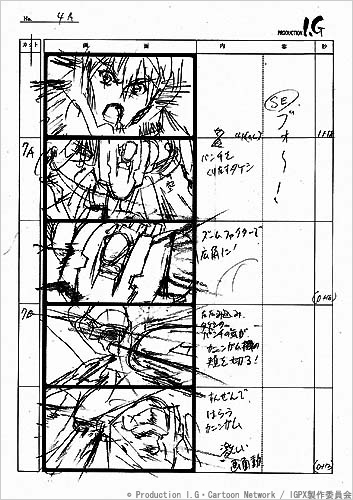
Do you intentionally do the motion rendering based on the specifications of each IG machine?
Yoshida: In the second season, each character began to show distinctive personalities, so we tried to portray these unique characters of pilots in the machine movements. Although IG machines are solid objects, we are consciously trying to recreate the images of their pilots' personalities.
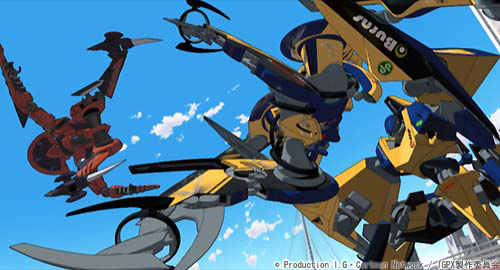
© 2005 Production I.G, Cartoon Network, Bandai Visual, Bandai Entertainment. All Rights Reserved.

![WORK LIST[DETAILS]](/contents/works/design/images/left_title.gif)



 terms of use
terms of use